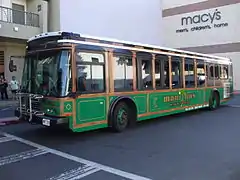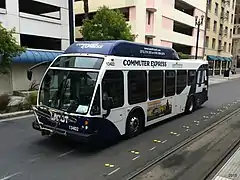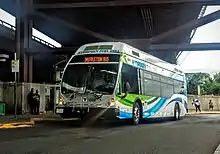ENC Axess
The ENC Axess is a line of low-floor transit buses available in 35' and 40' nominal lengths manufactured by ENC, formerly ElDorado National–California, in Riverside, California starting from 2003. In addition to the different available lengths, the buses were sold with a variety of prime movers, ranging from conventional diesel and LNG/CNG combustion engines to diesel-electric hybrid and hydrogen fuel cell with a traction motor.
| ENC Axess | |
|---|---|
  | |
| Overview | |
| Manufacturer | ENC |
| Production |
|
| Assembly | Riverside, California |
| Body and chassis | |
| Class | Transit bus |
| Body style | Monocoque |
| Layout | RR |
| Powertrain | |
| Engine |
|
| Transmission | |
| Dimensions | |
| Wheelbase | |
| Length | |
| Width | 102 in (2.59 m)[1][2] |
| Height | |
| Curb weight | |
The Axess was the first full-size heavy-duty transit bus offered by ENC. Previously, ENC had built mid-size heavy-duty transit and shuttle buses (up to 35' nominal length), including the E-Z Rider. In 2010, ENC began offering the Axess with an extended front cap and raked windshield as the Axess BRT, intended for bus rapid transit service; the conventional Axess was discontinued in 2015 and the Axess BRT became the sole styling option offered.
Design
ElDorado National (California) filed an application in 2002 to trademark the name Axess, and the cited date of first use is 2003.[7] It is the first heavy-duty transit bus offered by ElDorado National, who was better known previously for offering shuttle buses for universities, airport hotels, small transit fleets, and car rental services.[8] Like most low-floor buses offered in North America, the Axess has a partial low-floor layout, where the seating area from the rear axle to the back of the bus is on an elevated platform to provide space for the engine and transmission.[1][2] The CNG fueled variant is approximately 10% more expensive than the diesel.[9]
The Axess BRT model increased overall length from 40 ft 8 in (12.4 m)[4] to 41 ft 3 in (12.6 m),[3][5] increasing the front overhang from 94 to 100 in (2.4 to 2.5 m).[4][3]
Hybrid
The Axess is available with a hybrid drivetrain, at approximately a 50% premium compared to the cost of a bus with a conventional diesel engine.[9] The supplemental electric traction motor and hybrid components are part of the EP System supplied by Allison Transmission, which automatically switches between parallel hybrid and series hybrid operation.[10][11]
Fuel cell

The fuel cell variant of the Axess was developed under the sponsorship of the Federal Transit Administration as the American Fuel Cell Bus Project (AFCB Project), one of the projects established by the National Fuel Cell Bus Program (NFCB Program) in 2006.[12]:8 The AFCB Project was led by CALSTART and SunLine Transit Agency.[13] Although AFCB was part of the initial round of NFCB Program grants starting in 2006, the planned manufacturing partners, including the bus platform vendor (New Flyer), fuel cell (UTC Power), and hybrid drivetrain (ISE Corporation),[14] all withdrew from the AFCB Project shortly after it began.[12]:16–17 ElDorado National had previously worked with SunLine on the earlier ISE/UTC ThunderVolt fuel cell/hybrid bus, supplying an E-Z Rider II 30' bus chassis in the early 2000s.[15][16]
After completing the Axess BRT chassis for the first AFCB, ElDorado National delivered it to BAE Systems in New York, who integrated the hybrid drivetrain and fuel cell systems; the first AFCB was delivered to SunLine in November 2011 as fleet number FC3.[12]:16–17 Revenue service at SunLine began in January 2012;[13] FC3 met "Buy America" certification for American-made component content.[17]
The fuel cell variant of the Axess uses an electric drivetrain that was developed by BAE Systems as a series hybrid for hybrid bus applications and branded HybriDrive. Unlike the conventional HybriDrive, which uses a motor-generator set to power the electric traction motor, electricity is generated by a 150 kW Ballard Power Systems FCveloCity-HD6 hydrogen fuel cell, with additional power supplied by a lithium-ion storage battery capable of providing 200 kW of power and a capacity of 11.2 kW-hr. Up to 50 kg (110 lb) of gaseous hydrogen fuel can be stored on board, compressed to 350 bar (5,100 psi).[18] The electric traction motor has a continuous output rating of 215 hp (160 kW) and a peak output of 270 hp (200 kW).[6]
A second-generation fuel cell bus, now branded Axess-FC, was unveiled in 2019 with improved range.[19]
Deployment
125 Axess buses were shipped to airport facilities in California and Florida in 2004 and 2005. Some of the buses shipped to Fort Lauderdale–Hollywood International Airport had diesel-electric hybrid powertrains.[20]
AFCB operators
Before FC3 entered revenue service with SunLine Transit as the first fuel cell Axess, the E-Z Rider II-based ThunderVolt bus had been assigned SunLine Transit fleet number FC1 in 2002,[16] and a subsequent New Flyer Industries H40LFR-based bus (originally built for BC Transit) was assigned FC2.[21] SunLine received eight additional AFCBs with the same drivetrain as FC3 and improvements to the battery and fuel cell cooling systems[22]:4–5 between 2014 and 2018, which were assigned fleet numbers FC4 through FC12 (skipping FC7).[23]:10 FC7 was a variant of the Axess-based AFCB, built as a "battery dominant" bus with a lower fuel cell output.[24]
Unlike FC3, which had its powertrain and fuel cell installed in New York, the subsequent AFCBs were all assembled entirely at ElDorado National's Riverside, California factory.[22] By July 2018, ENC had produced 20 fuel cell buses for transit agencies throughout California,[25] including SunLine, UC Irvine (2015),[26] and OCTA (2016).[27] Also in 2018, the AFCB/Axess-FC was the first fuel cell bus to complete the heavy-duty transit bus (12-year/500,000 mi (800,000 km) lifecycle) testing at Altoona, Pennsylvania.[6][28]
In 2017, MBTA bus operations announced plans to test an AFCB/Axess;[29] an earlier MBTA fuel cell bus was designed in 2008 with a Nuvera/Fiat fuel cell and a BAE HybriDrive hybrid powertrain.[30]:33
Competition
References
- "Axess (brochure)" (PDF). ENC. Retrieved February 1, 2021.
- "Axess Fuel Cell (brochure)" (PDF). ENC. Retrieved February 1, 2021.
- ElDorado National Model Axess, report PTI-BT-R1315-P (PDF) (Report). Bus Testing and Research Center of the Pennsylvania Transportation Institute. 2013. Retrieved January 27, 2021.
- ElDorado National Model Axess, report PTI-BT-R0312 (PDF) (Report). Bus Testing and Research Center of the Pennsylvania Transportation Institute. November 2003. Retrieved January 27, 2021.
- ElDorado National Model Axess HD, report PTI-BT-R1312 (PDF) (Report). Bus Testing and Research Center of the Pennsylvania Transportation Institute. September 2014. Retrieved January 27, 2021.
- ElDorado National Model Axess FC, report PTI-BT-R1611 (PDF) (Report). Bus Testing and Research Center of the Pennsylvania Transportation Institute. April 2018. Retrieved January 27, 2021.
- "Axess, application No. 78149304". United States Patent and Trademark Office. Retrieved February 1, 2021.
- Brophy, Jim (September 26, 2020). "Bus Stop Classics: Transmark RE/Eldorado – If You Rented a Car in the US, You've Probably Rode On This Bus". Curbside Classic. Retrieved February 4, 2020.
- "ADA Accessible Heavy Duty Buses, Contract # 6813" (PDF). Iowa Department of Transportation, Purchasing Section. September 2015. Retrieved February 4, 2021.
- "Allison Hybrid H 40 EP / H 50 EP" (PDF). Allison Transmission. 2011. Retrieved February 4, 2021.
- "Allison Transmission Produces its 5,000th Hybrid System for Buses and Coaches" (Press release). Allison Transmission. November 14, 2011. Retrieved February 4, 2021.
- Eudy, Leslie; Chandler, Kevin (June 2013). American Fuel Cell Bus Project: First Analysis Report (PDF) (Report). Federal Transit Administration. Retrieved February 1, 2021.
- "American Fuel Cell Bus Project" (PDF). National Renewable Energy Laboratory. February 2012. Retrieved February 1, 2021.
- "SunLine Begins Extended Testing of Hybrid Fuel Cell Bus" (PDF). Department of Energy, Hydrogen Program. June 2008. Retrieved February 3, 2021.
- "SunLine Test Drives Hydrogen Bus" (PDF). United States Department of Energy. August 2003. Retrieved February 1, 2021.
- Chandler, Kevin; Eudy, Leslie (November 2003). Fuel Cell Transit Buses: ThunderPower Bus Evaluation at SunLine Transit Agency (PDF) (Report). National Renewable Energy Laboratory.
- "SunLine Transit unveils 7th generation hydrogen-fueled bus". Green Car Congress. November 15, 2011. Retrieved February 3, 2021.
- "American Fuel Cell Bus" (PDF). BAE Systems. 2011. Retrieved February 1, 2021.
- "ENC introduces next generation of fuel cell buses". Mass Transit (Press release). ElDorado National. September 27, 2019. Retrieved February 1, 2021.
- Annual Report (PDF) (Report). Thor Industries. 2005. Retrieved February 4, 2021.
- Eudy, Leslie; Chandler, Kevin (January 2013). SunLine Transit Agency Advanced Technology Fuel Cell Bus Evaluation: Fourth Results Report (Report). National Renewable Energy Laboratory. doi:10.2172/1083361.
- Eudy, Leslie; Post, Matthew (September 2015). American Fuel Cell Bus Project Evaluation: Second Report (Report). National Renewable Energy Laboratory. doi:10.2172/1225502.
- Eudy, Leslie; Post, Matthew (April 2020). SunLine Transit Agency American Fuel Cell Bus Progress Report, Data Period Focus: January 2017–July 2019 (Report). National Renewable Energy Laboratory. doi:10.2172/1659871.
- Le Flore, Rudy (June 6, 2019). "Today's Transit for Tomorrow's World: Making the Case for Hydrogen Bus Technology" (PDF). California Transit Association. Retrieved February 4, 2021.
- "Ballard-Powered El Dorado Fuel Cell Electric Buses Ready to Deliver Zero-Emission Transit Throughout California" (Press release). Ballard Power Systems. July 16, 2018. Retrieved February 1, 2021.
- "UC Irvine debuts zero-emission fuel cell bus powered by Ballard". Metro Magazine. May 4, 2015. Retrieved February 4, 2021.
- "Zero-Emission Fuel Cell Electric Bus Service Begins in Orange County, California" (Press release). Center for Transportation and the Environment. May 26, 2016. Retrieved February 4, 2021.
- "ENC's hydrogen powered bus, the Axess-FC, becomes first transit bus to complete Altoona testing" (Press release). REV Group. August 15, 2018. Retrieved February 1, 2021.
- "Massachusetts Fuel Cell Bus Project" (PDF). National Renewable Energy Laboratory. May 2017. Retrieved February 1, 2021.
- Chandler, Kevin L.; Eudy, Leslie (March 2012). FTA Fuel Cell Bus Program: Research Accomplishments through 2011 (PDF) (Report). Federal Transit Administration. Retrieved February 4, 2021.
| Wikimedia Commons has media related to ElDorado Axess. |
External links
- "Axess". ElDorado National. Retrieved January 27, 2021.
- "Axess-FC". ElDorado National. Retrieved January 27, 2021.
- "ElDorado National Axess". Canadian Public Transit Discussion Board wiki. Retrieved February 1, 2021.
- "ElDorado National Axess BRT". Canadian Public Transit Discussion Board wiki. Retrieved February 1, 2021.
- "Axess (brochure)" (PDF). ElDorado National Online. February 2006. Archived from the original (PDF) on March 26, 2010.
- "Buyer's Order Contract and Purchasing Specification". City of Burbank. July 1, 2016. Retrieved February 2, 2021.